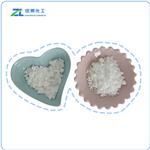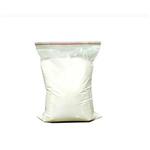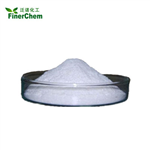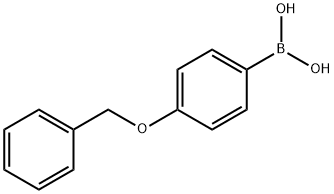Monobenzone
- CAS No.
- 103-16-2
- Chemical Name:
- Monobenzone
- Synonyms
- MONOBENZONE;HYDROQUINONE MONOBENZYL ETHER;PBP;Monobenzon;Monobenzone powder;Alba;Benoquin;Benzoquin;oxyphenoL;P-BENZYLOXYPHENOL
- CBNumber:
- CB2156828
- Molecular Formula:
- C13H12O2
- Molecular Weight:
- 200.23
- MDL Number:
- MFCD00002333
- MOL File:
- 103-16-2.mol
- MSDS File:
- SDS
| Melting point | 119-120 °C (lit.) |
|---|---|
| Boiling point | 297.96°C (rough estimate) |
| Density | 1,26 g/cm3 |
| refractive index | 1.5906 (estimate) |
| storage temp. | Store below +30°C. |
| solubility | Chloroform (Slightly), DMSO (Slightly), Methanol (Slightly) |
| pka | 10.29±0.15(Predicted) |
| form | Powder, Crystals, and/or Chunks |
| color | Off-white to beige to brown |
| Water Solubility | slightly soluble |
| Merck | 14,6248 |
| BRN | 1958305 |
| InChIKey | VYQNWZOUAUKGHI-UHFFFAOYSA-N |
| LogP | 2.651 (est) |
| Indirect Additives used in Food Contact Substances | HYDROQUINONE MONOBENZYL ETHER |
| FDA 21 CFR | 175.105; 177.2600 |
| CAS DataBase Reference | 103-16-2(CAS DataBase Reference) |
| FDA UNII | 9L2KA76MG5 |
| NCI Drug Dictionary | Benoquin |
| ATC code | D11AX13 |
| NIST Chemistry Reference | Monobenzone(103-16-2) |
| EPA Substance Registry System | Monobenzone (103-16-2) |
SAFETY
Risk and Safety Statements
| Symbol(GHS) |  GHS07 |
|||||||||
|---|---|---|---|---|---|---|---|---|---|---|
| Signal word | Warning | |||||||||
| Hazard statements | H317-H319 | |||||||||
| Precautionary statements | P280-P305+P351+P338 | |||||||||
| Hazard Codes | Xi | |||||||||
| Risk Statements | 36-43 | |||||||||
| Safety Statements | 24/25-26-37 | |||||||||
| WGK Germany | 2 | |||||||||
| RTECS | SJ7700000 | |||||||||
| Hazard Note | Irritant | |||||||||
| TSCA | Yes | |||||||||
| HS Code | 29095090 | |||||||||
| Toxicity | LD50 i.p. in mice: >600 mg/kg (Takahashi) | |||||||||
| NFPA 704 |
|
Monobenzone price More Price(43)
| Manufacturer | Product number | Product description | CAS number | Packaging | Price | Updated | Buy |
|---|---|---|---|---|---|---|---|
| Sigma-Aldrich | SAB4502265 | Anti-MED1 antibody produced in rabbit affinity isolated antibody | 100μG | $506 | 2024-03-01 | Buy | |
| Sigma-Aldrich | 158348 | 4-(Benzyloxy)phenol 98% | 103-16-2 | 25g | $49.9 | 2024-03-01 | Buy |
| Sigma-Aldrich | PHR3208 | Monobenzone pharmaceutical secondary standard, certified reference material | 103-16-2 | 500MG | $139 | 2024-03-01 | Buy |
| Sigma-Aldrich | 1445506 | Monobenzone United States Pharmacopeia (USP) Reference Standard | 103-16-2 | 200mg | $436 | 2024-03-01 | Buy |
| TCI Chemical | B1104 | 4-(Benzyloxy)phenol >99.0%(GC) | 103-16-2 | 25g | $39 | 2024-03-01 | Buy |
Monobenzone Chemical Properties,Uses,Production
Description
4-(Benzyloxy)phenol, also called monobenzone and monobenzyl ether of hydroquinone (MBEH) is an organic chemical in the phenol family with chemical formula C6H5CH2OC6H4OH. It is used as a topical drug for medical depigmentation. Monobenzone occurs as a white, almost tasteless crystalline powder, soluble in alcohol and practically insoluble in water.
The topical application of monobenzone in animals, increases the excretion of melanin from the melanocytes. The same action is thought to be responsible for the depigmenting effect of the drug in humans.
Chemical Properties
4-Benzyloxyphenol is a cream to beige-light brownish crystals classified as a hydroquinone monobenzyl ether. It is soluble in alcohol, benzene and ether, and almost insoluble in water. 4-Benzyloxyphenol is a depigmenting agent that has the effect of enhancing the rate of elimination of melanin secreted by skin cells, and studies have shown that the molecular mechanism of its action may be related to tyrosinase.
Uses
Hydroquinone monobenzyl ether is an antidegradant added to rubber products; inhibitor in acrylic resins.
Uses
4-Benzyloxyphenol is used in the synthesis of bis(4-benzyloxyphenoxy)phenyl phosphine oxide. It plays an essential role in the preparation of hetaryl-azophenol dyes via heterocyclic amines in nitrosyl sulphuric acid. It is also used for polyester fiber dyeing and in rubber industry. It acts as a depigmenting agent.
Uses
PBP is used as antiinflammatory, antisecretory, antiulcer.
Indications
Monobenzone (Benoquin) potently inhibits melanin production and destroys melanocytes. Like hydroquinone, monobenzone was originally introduced for the topical treatment of disorders of excess melanin pigmentation, including melasma. It is now used only to permanently depigment the remaining normally pigmented skin in patients with extensive vitiligo. Irritant and allergic contact dermatitis are common side effects.
Definition
ChEBI: Monobenzone is the monobenzyl ether of hydroquinone. It is used as a topical drug for medical depigmentation. It has a role as a melanin synthesis inhibitor, a dermatologic drug and an allergen. It derives from a hydroquinone.
Preparation
4-Benzyloxyphenol Synthesis: Add 2.63g (0.028mol) of hydroquinone to a 100mL conical flask, weigh 1.12g (0.028mol) of sodium hydroxide, add 8mL of water, wait for the sodium hydroxide to dissolve and add dropwise to the conical flask with hydroquinone, shake well, then add 15mL of DMF and 2.52g (0.02mol) of benzyl chloride, under microwave radiation power of 320W The reaction was cooled to room temperature at the end of the reaction. The reaction was first adjusted to alkalinity with 10% sodium hydroxide, filtered, and the filtrate was washed with 10% sodium hydroxide until the filtrate was colorless (the filtrate was hydroquinone bis(benzyl ether), which could be recycled). The filtrate was acidified with hydrochloric acid to make Monobenzone completely precipitated, and then washed by filtration and ice water, recrystallized with alcohol and water, and decolorized by activated carbon to obtain 2.55g of white solid, the yield was 63.79%.
brand name
Benoquin (Valeant).
Origin
Monobenzone (monobenzyl ether of hydroquinone, MB) is a depigmenting agent that was discovered by Oliver et al. in 1939. It has been approved by the FDA as a cream formulation for skin depigmentation of patients with vitiligo. The mechanism of action for depigmentation by MB is correlated with the inhibition of tyrosinase[1]. The compound also is cytotoxic to melanocytes and melanoma cells and increases melanocyte and melanoma cell immunogenicity.
Synthesis Reference(s)
Tetrahedron Letters, 33, p. 5129, 1992 DOI: 10.1016/S0040-4039(00)61209-1
Biological Activity
The skin-depigmenting effect of MB is correlated with the inhibition of tyrosinase, the rate-limiting enzyme in melanin synthesis, in both melanocytes and melanoma cells. The metabolites of MB have been proven to exert toxic effects on melanocytes and increase melanocyte and melanoma cell immunogenicity. MB potently inhibited RNR enzyme activity by targeting RRM2 and thereby suppressed AML cell growth in vitro and in a mouse xenograft experiment[1-2].
Side effects
Side effects:
Allergic reaction: Itching or hives, swelling in your face or hands, swelling or tingling in your mouth or throat, chest tightness, trouble breathing
Intense itching, blistering, burning, or swelling of the skin.
Mild skin rash, tenderness, or redness.
Purification Methods
Crystallise it from EtOH or H2O, and dry (P2O5) under vacuum. [Walter et al. J Am Chem Soc 108 5210 1986, Beilstein 6 IV 5778.]
References
[1] Jingwen Dong. “Identification of Monobenzone as a Novel Potential Anti-Acute Myeloid Leukaemia Agent That Inhibits RNR and Suppresses Tumour Growth in Mouse Xenograft Model.” Cancers (2022).
[2] Jasper G. van den Boorn . “Skin-Depigmenting Agent Monobenzone Induces Potent T-Cell Autoimmunity toward Pigmented Cells by Tyrosinase Haptenation and Melanosome Autophagy.” Journal of Investigative Dermatology 131 6 (2011): Pages 1240-1251.
Monobenzone Preparation Products And Raw materials
| Supplier | Tel | Country | ProdList | Advantage | |
|---|---|---|---|---|---|
| Alfa Chemistry | Info@alfa-chemistry.com | United States | 24072 | 58 | |
| Hubei Aumei New Material Co., Ltd. | +86-027-87366298 +8615927270571 | tianyi@skbiology.cn | China | 282 | 58 |
| XI AN SGONEK BIOLOGICAL TECHNOLOGY CO., LTD | 15202951039 | jason@sgonekbio.com | China | 268 | 58 |
| Guangzhou Tengyue Chemical Co., Ltd. | +86-86-18148706580 +8618826483838 | evan@tyvovo.com | China | 149 | 58 |
| Shaanxi Haibo Biotechnology Co., Ltd | +undefined18602966907 | qinhe02@xaltbio.com | China | 997 | 58 |
| Beri Pharma Co., Ltd. | +8613417710166 | sales@zhberi.com | China | 227 | 58 |
| Hebei Chuanghai Biotechnology Co,.LTD | +86-13131129325 | sales1@chuanghaibio.com | China | 5893 | 58 |
| JiangXi Bobert Imp&Exp Co.,LTD | +8618071643627 | rze2024@163.com | China | 226 | 58 |
| Hebei Weibang Biotechnology Co., Ltd | +8615531157085 | abby@weibangbio.com | China | 8813 | 58 |
| Shaanxi Dideu Medichem Co. Ltd | +86-29-81148696 +86-15536356810 | 1022@dideu.com | China | 3882 | 58 |
Related articles
- Adverse Reactions of Monobenzone
- Monobenzone is a depigmenting agent. It works by increasing elimination of melanin (pigment molecules) from skin cells.
- Apr 7,2022
- What is Monobenzone used for?
- Monobenzone, also called 4-(Benzyloxy)phenol and monobenzyl ether of hydroquinone (MBEH) is an organic chemical in the phenol ....
- Feb 21,2022
- All you need to know about monobenzone(PBP)
- Monobenzone (CAS: 103-16-2), also called PBP or monobenzyl ether of hydroquinone (MBEH) is an organic chemical in the phenol f....
- Jan 7,2020
View Lastest Price from Monobenzone manufacturers
| Image | Update time | Product | Price | Min. Order | Purity | Supply Ability | Manufacturer | |
|---|---|---|---|---|---|---|---|---|
 |
2024-11-13 | Monobenzone
103-16-2
|
US $100.00-80.00 / kg | 1kg | 99% | 5000kg/ week | Hebei Zhuanglai Chemical Trading Co.,Ltd | |
 |
2024-11-13 | PBP
103-16-2
|
US $6.00 / kg | 1kg | 99% | 2000KG/Month | HebeiShuoshengImportandExportco.,Ltd | |
 |
2024-11-13 | Monobenzone
103-16-2
|
US $0.00 / Kg/Drum | 1KG | 99% | 100mt | Jinan Finer Chemical Co., Ltd |
-

- Monobenzone
103-16-2
- US $100.00-80.00 / kg
- 99%
- Hebei Zhuanglai Chemical Trading Co.,Ltd
-

- PBP
103-16-2
- US $6.00 / kg
- 99%
- HebeiShuoshengImportandExportco.,Ltd
-

- Monobenzone
103-16-2
- US $0.00 / Kg/Drum
- 99%
- Jinan Finer Chemical Co., Ltd
103-16-2(Monobenzone)Related Search:
1of4







